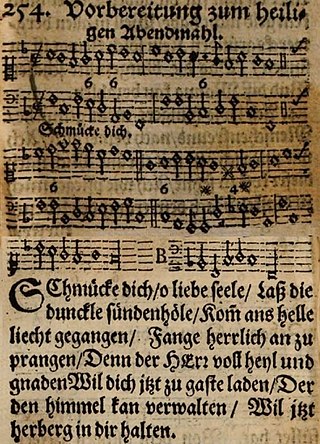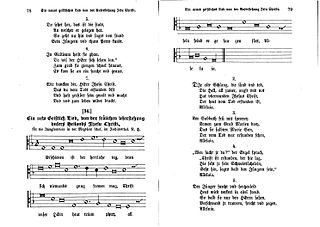
"O Sacred Head, Now Wounded" is a Christian Passion hymn based on a Latin text written during the Middle Ages. Paul Gerhardt wrote a German version which is known by its incipit, "O Haupt voll Blut und Wunden".

"O Welt, sieh hier dein Leben" is a Lutheran Passion hymn in German by Paul Gerhardt. In 16 stanzas of 6 lines, it was first published in 1647 in Johann Crüger's Praxis pietatis melica. The hymn is known as the source for chorales in Bach's Passions. It was translated to English in several versions, for example "O, World! behold upon the tree" by Catherine Winkworth in 1858.

"Vom Himmel hoch, da komm ich her" is a hymn text relating to the Nativity of Jesus, written by Martin Luther in 1534. The hymn is most often sung to the melody, Zahn No. 346, which first appeared in a 1539 songbook and was probably also composed by Luther. This classic Christmas carol remains popular and has inspired many choral and organ works by other composers.
"Warum sollt ich mich denn grämen" is a Lutheran hymn with a text by Paul Gerhardt written in 1653. It was first published that same year in the fifth edition of Johann Crüger's hymnal Praxis Pietatis Melica, set to a melody composed by Crüger. In the 1993 Protestant hymnal, Evangelisches Gesangbuch, it appears as number 370 with a melody composed by Johann Georg Ebeling, which was published with the divergent title "Warum sollt ich mich doch grämen" in Pauli Gerhardi Geistliche Andachten in 1666.

Schemellis Gesangbuch is the common name of a collection of sacred songs titled Musicalisches Gesang-Buch published in Leipzig in 1736 by Georg Christian Schemelli, to which Johann Sebastian Bach contributed.
"Herzlich tut mich verlangen" is a German hymn, with lyrics written in 1599 by Christoph Knoll, with a melody adapted from a secular song by Hans Leo Hassler. It is a prayer for a blessed death, beginning "Herzlich tut mich verlangen nach einem sel'gen End". Its hymn tune, Zahn No. 5385a, was later also used for Paul Gerhardt's "Befiehl du deine Wege" and "O Haupt voll Blut und Wunden".

"Schmücke dich, o liebe Seele" is a Lutheran hymn in German, with lyrics by Johann Franck and a hymn tune by Johann Crüger. It was first published in Crüger's 1649 Geistliche Kirchen-Melodien, and was later adopted in other hymnals, such as the 1653 edition of his Praxis pietatis melica.

"Allein Gott in der Höh sei Ehr" is an early Lutheran hymn, with text and melody attributed to Nikolaus Decius. With the reformers intending church service in German, it was intended as a German version of the Gloria part of the Latin mass, used in almost every service. Decius wrote three stanzas, probably in 1523, while a fourth was added, probably by Joachim Slüter.

"In dich hab ich gehoffet, Herr" is a Lutheran hymn in seven stanzas, written by Adam Reusner and first published in 1533. He paraphrased the beginning of Psalm 31. It was first sung to the melody of a Passion hymn. The melody connected with the hymn in 1560 was derived from models dating back to the 14th century. A third melody from 1608 became a hymn tune for several other songs and translations to English. In the German Protestant hymnal Evangelisches Gesangbuch, the hymn appears as EG 257 with the second melody. Johann Sebastian Bach used the second and third melodies in chorale preludes, and the third also in cantatas and the St Matthew Passion.

"Was mein Gott will, das g'scheh allzeit" is a Lutheran hymn in German. The text from c. 1550 is attributed to Albert, Duke of Prussia. The melody, Zahn No. 7568, goes back to a tune by Claudin de Sermisy, written in 1529 for a secular French song. The hymn has belonged to core Lutheran hymnody without interruption and is part of the Protestant hymnal Evangelisches Gesangbuch as EG 364.

"Erschienen ist der herrlich Tag" is a German Easter hymn, with text and tune written by Nikolaus Herman and published in 1561. It has inspired musical settings by composers from the 17th to the 20th century. It appears in several hymnals, including the German Protestant hymnal Evangelisches Gesangbuch. Other hymns, especially Easter hymns, in both German and English, are sung to the same melody.

"Fröhlich soll mein Herze springen" is a Christian Christmas hymn by Paul Gerhardt, originally in 15 stanzas in artful metre. It was first published, "Frölich sol mein hertze springen", in 1653 in the fifth edition of the hymnal Praxis Pietatis Melica by Johann Crüger, who also created a melody. Johann Sebastian Bach used it as a chorale in his Christmas Oratorio, with a different melody by Johann Georg Ebeling. The song is part, with twelve stanzas, of the current Protestant hymnal Evangelisches Gesangbuch and other songbooks.

"Die güldne Sonne voll Freud und Wonne" is a Lutheran hymn by Paul Gerhardt. It is a morning hymn which was first published in 1666, with a four-part setting by Johann Georg Ebeling. Gerhardt created an unusual hymn metre for its 12 stanzas.
"Auf meinen lieben Gott" is a Lutheran hymn from the 17th century. Several hymns are sung to the same hymn tune, including "Wo soll ich fliehen hin", and it was set in compositions. The hymn was translated into English as "In God, My Faithful God". It is part of modern hymnals and songbooks.

"Liebster Jesu, wir sind hier" is a Lutheran hymn with text written by Tobias Clausnitzer in 1663, and a hymn tune, Zahn No. 3498b, based on a 1664 melody by Johann Rudolph Ahle. A prayer for illumination, it is suitable for the opening of a church service and to be sung before a sermon. The song is part of the Protestant hymnal Evangelisches Gesangbuch as EG 161. It is also part of the Catholic hymnal Gotteslob as GL 149. It is popular also in English translations such as "Blessed Jesus, at your word" by Catherine Winkworth.
Jesu, meines Glaubens Zier is a German Lutheran hymn by Gottfried Wilhelm Sacer, first published in 1661. Its hymn tune, Zahn No. 6453, was first published in 1714, in Freylinghausen's hymnal. In 1736 the hymn was adopted in Schemellis Gesangbuch, with a figured bass accompaniment which may have been contributed by Johann Sebastian Bach (BWV 472).

"Liebster Gott, wann werd ich sterben" is a Lutheran hymn which Caspar Neumann, an evangelical theologian from Breslau, wrote around 1690. The topic of the hymn, which has five stanzas of eight lines, is a reflection on death. An elaborate analysis of the hymn's content was published in 1749. A few text variants of the hymn originated in the 18th century. Neumann's text is usually sung to the hymn tune of "Freu dich sehr o meine Seele".
"Lobpreiset all zu dieser Zeit" is a Christian hymn in German for a new year with text by Heinrich Bone written in 1851. It is contained in the Catholic hymnal Gotteslob. It is sung to a melody that Martin Luther created in 1529.
"Dir, dir, Jehova, will ich singen" is a Lutheran hymn, with 1695 text by Bartholomäus Crasselius. A melody attributed to Johann Sebastian Bach appeared in Schemellis Gesangbuch. It was translated into English by Catherine Winkworth in 1863 as "Jehovah, let me now adore Thee". The song became part of many German hymnals, such as Evangelisches Gesangbuch and Gotteslob. From the 1930s, the hymn has often been rendered as "Dir, dir, o Höchster, will ich singen".














